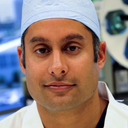I have keloids that were surgically removed. Within a year, they grew back even larger. If I get them removed again, will they keep growing back? What causes this?
Answers (10)
From board-certified doctors and trusted medical professionals
Dr. Young R. Cho, MD, PhD

Dr. Young R. Cho, MD, PhD
Board Certified Plastic Surgeon
Answer
Dr. Steven H. Williams, MD

Dr. Steven H. Williams, MD
Board Certified Plastic Surgeon
Answer
Dr. Raffy Karamanoukian, MD, FACS

Dr. Raffy Karamanoukian, MD, FACS
Board Certified Plastic Surgeon
Answer
Dr. Farbod Esmailian, MD

Dr. Farbod Esmailian, MD
Board Certified Plastic Surgeon
Answer
Dr. Sam Jejurikar, MD

Dr. Sam Jejurikar, MD
Board Certified Plastic Surgeon
Answer
Dr. Otto Joseph Placik, MD

Dr. Otto Joseph Placik, MD
Board Certified Plastic Surgeon
Answer
Dr. Hisham Seify, MD, PhD, FACS
Dr. Hisham Seify, MD, PhD, FACS
Board Certified Plastic Surgeon
Answer
Dr. Bryan K. Chen, MD
Dr. Bryan K. Chen, MD
Board Certified Dermatologist
Answer
Dr. Theodore Katz, MD, FACS (retired)
Dr. Theodore Katz, MD, FACS (retired)
Board Certified Plastic Surgeon
Answer
Dr. Arnold R. Oppenheim, MD (retired)
Dr. Arnold R. Oppenheim, MD (retired)
Board Certified Dermatologist
Answer
More Scar Removal Questions
See all Scar Removal Q&AWE SEND PRETTY
EMAILS
What’s trending? Who’s turning heads? Which TikTok myths need busting? We’ve got you. No fluff, no gatekeeping—just real talk. Get our free, unfiltered newsletter.